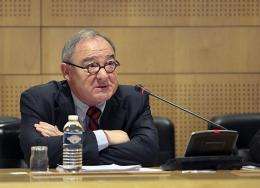2011 to be 'revolution' for Europe in space - ESA

Europe is set for a space "revolution" in 2011 when two new types of rocket join its launch pad in French Guiana, European Space Agency (ESA) boss Jean-Jacques Dordain said on Friday.
ESA's Ariane 5 heavy launcher is to be joined at Kourou this year by a tried-and-tested workhorse of space, Russia's medium-sized Soyuz, and by a new European-designed rocket, Vega, for small payloads.
"2011 will be the year of the launchers," Dordain said at a press conference at ESA headquarters.
"We will go from having one launcher to having three. It will transform our capacity."
Dordain cautioned that both Soyuz and Vega had to undergo tests before being certified for operation and ESA faced the challenge of having to master three different rocket types at the same time.
But, he declared, "By the end of 2011, ESA will not look like it does today. It is a revolution for Europe."
The Ariane 5 can place up to 9.5 tonnes in low Earth orbit, while the capacity of Soyuz is rated at three tonnes and that of Vega at 1.5 tonnes.
Having a choice of rockets will give ESA greater flexibility for its scientific payloads and widen the operational menu for Arianespace, a joint company that is the world's biggest launcher of commercial satellites.
Other highlights in ESA's year include the launch of its second robot freighter, named the Johannes Kepler, to the International Space Station (ISS) on February 15.
The first two operational satellites in Europe's Galileo system, a rival to the US Global Positioning System (GPS), are scheduled for launch by Soyuz in August-September, said Dordain.
Romania, meanwhile, is set to be admitted as ESA's 19th member, and Israel is scheduled to sign a cooperation agreement.
The budget for 2011 has been set at 3.99 billion euros (5.34 billion dollars), of which 75 percent comes from member states and around 20 percent from the European Union (EU), with which ESA has a partnership agreement.
Earth observation missions -- satellites that scan the planet to garner scientific knowledge or monitor its environmental health -- account for 21 percent of the total.
Other big spending items are scientific exploration of the Solar System; navigation, including Galileo; and manned missions to the ISS.
ESA sends astronauts to and from the orbital outpost using Russian and US transport. It does not have its own manned flight capability.
(c) 2011 AFP



















